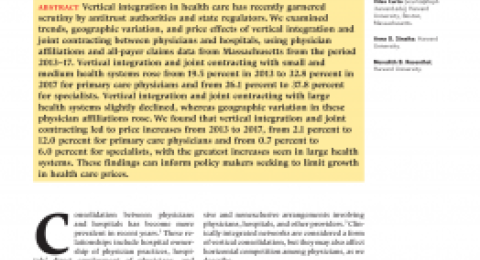
Contact: Vilsa Curto
Email: vcurto@hsph.harvard.edu
Vertical integration in health care has recently garnered scrutiny by antitrust authorities and state regulators. We examined trends, geographic variation, and price effects of vertical integration and joint contracting between physicians and hospitals, using physician affiliations and all-payer claims data from Massachusetts from the period 2013–17. Vertical integration and joint contracting with small and medium health systems rose from 19.5 percent in 2013 to 32.8 percent in 2017 for primary care physicians and from 26.1 percent to 37.8 percent for specialists. Vertical integration and joint contracting with large health systems slightly declined, whereas geographic variation in these physician affiliations rose. We found that vertical integration and joint contracting led to price increases from 2013 to 2017, from 2.1 percent to 12.0 percent for primary care physicians and from 0.7 percent to 6.0 percent for specialists, with the greatest increases seen in large health systems. These findings can inform policy makers seeking to limit growth in health care prices.
